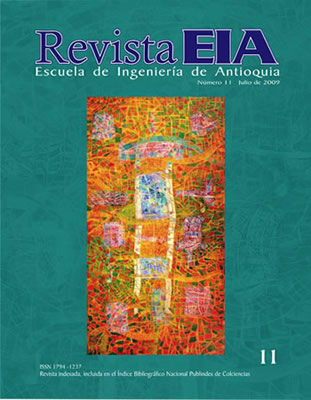APLICACIÓN DEL DISEÑO DE EXPERIMENTOS PARA EL ANÁLISIS DEL PROCESO DE DOBLADO (DESIGN OF EXPERIMENTS APPLICATION FOR BENDING PROCESS ANALYSIS)
APLICACIÓN DEL DISEÑO DE EXPERIMENTOS PARA EL ANÁLISIS DEL PROCESO DE DOBLADO (DESIGN OF EXPERIMENTS APPLICATION FOR BENDING PROCESS ANALYSIS)


This work is licensed under a Creative Commons Attribution-NonCommercial-NoDerivatives 4.0 International License.
Copyright statement
The authors exclusively assign to the Universidad EIA, with the power to assign to third parties, all the exploitation rights that derive from the works that are accepted for publication in the Revista EIA, as well as in any product derived from it and, in in particular, those of reproduction, distribution, public communication (including interactive making available) and transformation (including adaptation, modification and, where appropriate, translation), for all types of exploitation (by way of example and not limitation : in paper, electronic, online, computer or audiovisual format, as well as in any other format, even for promotional or advertising purposes and / or for the production of derivative products), for a worldwide territorial scope and for the entire duration of the rights provided for in the current published text of the Intellectual Property Law. This assignment will be made by the authors without the right to any type of remuneration or compensation.
Consequently, the author may not publish or disseminate the works that are selected for publication in the Revista EIA, neither totally nor partially, nor authorize their publication to third parties, without the prior express authorization, requested and granted in writing, from the Univeridad EIA.
Show authors biography
El artículo expone un estudio realizado sobre el proceso de doblado en una empresa, para determinar qué factores tienen efecto sobre las dimensiones (longitud y ángulo de doblado) de las piezas de metal obtenidas. Acorde con la metodología de Diseño de Experimentos se desarrolla este estudio, para el cual se consideraron cuatro factores (operario, dobladora, material y grosor del material), cada uno con dos niveles que fueron seleccionados de manera aleatoria de una población de posibles niveles. Dos réplicas se tomaron para cada combinación de tratamientos. Las corridas experimentales se hicieron de modo aleatorio para garantizar la ausencia de sesgo en la recolección de los datos. Con lo anterior se realizaron en total 32 corridas experimentales, correspondientes a 32 datos de longitud y 32 datos de ángulo, considerando todas las posibles combinaciones. El análisis de los resultados muestra que las dimensiones de las piezas dobladas fluctúan. Para la longitud de doblado, se encontró que existe variabilidad en la población de niveles de los factores Dobladora y Grosor y en la interacción Dobladora*Operario; respecto al ángulo de doblado, se encontraron variaciones en la población de niveles de los factores Operario y Grosor y la interacción Operario*Grosor. En síntesis, el proceso de doblado presenta variaciones considerables que pueden ser preocupantes a la hora de requerir mucha precisión para un proceso de ensamble posterior.
Abstract: The paper shows a study made about the bending process in a company, to define which factors have an effect on the dimensions (bending length and bending angle) of the metal pieces obtained. The study develops according to Design of Experiments methodology. For this study, four factors were considered (operator, bending machine, sheet material, sheet thickness) at two levels each factor. Levels were chosen at random from a variety of possible levels; two replicates were taken for each treatment combination. Experimental runs were made at random to ensure absence of systematic error in data obtaining. There were made 32 experimental runs representing 32 bending length data and 32 bending angle data with all possible combinations of factor levels. The data analysis shows that dimensions of bended pieces change. Relating the bending length, there are variability in levels of the factors Bending Machine and Thickness, and in the interaction Bending Machine*Operator. Considering bending angle, there are variability in levels of the factors Operator and Thickness and the interaction Operator*Thickness. In brief, bending process presents considerable variations that can be worrying when requiring great accuracy for a later assembly process.
Article visits 528 | PDF visits 181
